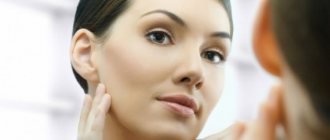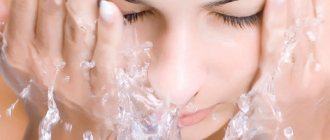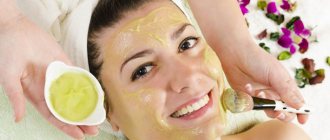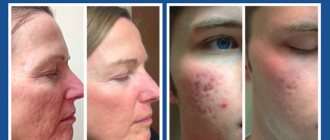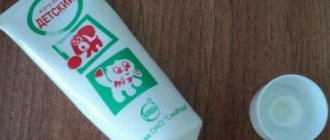Why does skin dry out?
The main cause of dry skin is a breakdown of the epidermal barrier.
Just as a wall is made of bricks, the epidermal barrier is made of dead stratum corneum scales (corneocytes). These scales hold each other like hands with the help of protein bridges (desmosomes). And the layer (cement) between the bricks of the skin is formed by lipids (also called fats).
When the barrier is damaged, lipids “march” out of the skin in orderly rows. The skin's protective system weakens. Moisture is not retained and intensively evaporates from the surface of the skin.
Other causes of dry skin
- cold;
- heat;
- low air humidity;
- UV radiation;
- wind;
- central heating;
- air conditioned;
- age (estrogen levels drop, the skin becomes thinner, sebum synthesis decreases, the protective barrier weakens);
- heredity;
- aggressive cosmetics (sulfates, alcohol, strong retinoids);
- constant contact with water;
- medications (contraceptives, retinoids, medications for high blood pressure, cholesterol, allergies);
- chronic conditions (hypothyroidism, hyperthyroidism, diabetes mellitus, vitamin A deficiency);
- pregnancy;
- poor diet, alcohol and caffeine;
- smoking;
- stress.
Dry skin will experience an acute deficiency of 2 things:
- lipids;
- moisture.
At the same time, dry skin always needs lipids and not always moisture. Dry skin is not always dehydrated. What is the difference? Let's figure it out.
Features and reasons
- Dry skin in youth is smooth, matte, without greasy shine. At the same time, without proper care, with age it becomes rougher, begins to peel, and loses elasticity.
- Over the years, the skin acquires a “parchment” appearance and shade.
- Washing is accompanied by an unpleasant feeling of tightness.
- The skin is sensitive to external factors and easily becomes inflamed.
- Wrinkles appear early.
What causes the skin to lose moisture?
- Lack of proper care.
- Prolonged exposure to frosty air or sunlight.
- Frequent sea baths or swimming in an artificial pond.
- Poor microclimate in the room (many heating devices and air conditioners dry out the air).
- Smoking.
- Taking medications.
- Vitamin deficiency.
- Stressful situations.
Thyroid diseases, metabolic disorders, gastrointestinal diseases, kidney diseases, allergic reactions, dermatological diseases (ichthyosis, psoriasis) reduce skin moisture.
Difference between dry and dehydrated skin
Dry
- Skin type or temporary skin condition. The skin is dry all year round or becomes dry from normal or even oily in winter.
- Dry skin lacks lipids .
- In this case, the amount of water is no less than in normal or oily skin.
- There is a feeling of tightness.
- The skin is peeling.
- The skin has difficulty absorbing cosmetics.
- Dry skin is prone to hypersensitivity and irritation.
Dehydrated
- Temporary skin condition. Occurs in any skin type (from dry to oily).
- Dehydrated skin lacks moisture.
- There is a feeling of tightness and dryness with visible oiliness and inflammation (dehydrated oily facial skin).
- Dehydrated skin instantly absorbs moisture. Moisturizing creams, masks, serums “sink” into the skin.
LaraBar Tips & Tricks
- For dry facial skin, choose creams with the word “nourishing” (nourishing).
- For dehydrated facial skin, choose creams with the words “moisturizing”, “hydrating” (hydra, hydrating).
- For dehydrated, dry facial skin, combine moisturizing and nourishing serums, creams and masks.
How to Remove Cleansers and Toners
Cleansers and toners for dry and sensitive facial skin must be removed after use with boiled water cooled to room temperature. To care for problem skin, be sure to boil water first, since it contains chlorine, magnesium and calcium with pathogenic microflora. This composition, harmful to the skin, must be neutralized by boiling water.
Melt water, as well as softened with soda or glycerin (1 tablespoon per 1 liter), is suitable for cleansing sensitive facial skin. Cosmetologists recommend herbal infusions and table bottled water. Regular use of homemade face masks provides positive results that prevent premature skin aging.
Treatment of dry facial skin
The main task when restoring dry facial skin is to “repair” the epidermal barrier.
So, what to do if you have dry skin on your face?
- Cleansing should be gentle (no soap or sulfates).
- And exfoliation is gentle (gommages and soft peelings).
- Use moisturizing and soothing toners. No alcohol.
- Add thermal water to your care.
- Choose the right cream. It should moisturize and nourish (contain lipids and humectants).
- Include nourishing serums with ceramides in your care.
- Be sure to apply SPF protection (sun-damaged skin is unable to retain moisture, the lipid layer is destroyed, the skin's immune system weakens, and regeneration slows down).
- Add oils (shea, argan, coconut, jojoba) to your care.
- Take fish oil and flaxseed oil (sources of omega-3 acids).
- Drink plenty of water.
- Buy a humidifier.
Who to Avoid
- Soap.
- Sulfates (alkali and anything that foams a lot).
- Alcohol.
- Irritating components (triclosan, menthol, mint, citrus, eucalyptus).
- Fragrance.
- Aggressive preservatives (imidazolidinyl urea, bronopol, iodopropynyl butylcarbamate, DMDM hydantoin).
- Hot water.
- Scrubs.
- Loofah sponges and stiff brushes.
- Rubbing.
- Frequent swimming in the pool (especially a chlorinated one).
Specifics of winter care procedures
Dry skin in winter is especially problematic. Frosty air dries out the skin of the face. It not only provokes peeling, but also causes the appearance of wrinkles. And the air in the room, dry from heating appliances, continues this destructive work. The rules for winter care for dry skin are as follows.
- Do not use scrubs in winter, as this product eliminates the thinnest fatty film that performs a protective function.
- You should not use gel formulations, since they also remove the protective layer of fat.
- You can and should use moisturizing creams, but you can apply them no earlier than forty minutes before going outside.
Cleansing dry facial skin
- Remove makeup with milk, cream, rich cream or oil.
- Wash only with gentle sulfate-free cream foams. It's good if your foam contains oils or ceramides. Like, for example, the Rosehip Oil Cleanser.
- If even soft foams cause discomfort, try cleansing with milk or micellar.
- In case of extreme dryness (xerosis, atopy - the skin becomes crusty and cracks), wash with herbal decoctions.
- Forget scrubs. Stay away from hard abrasives, nut shells and fruit shells.
- Instead of scrubs, use gommages or soft peels. The best acid for dry skin is lactic acid.
- Use soft sponges and sponges to remove flaking. No loofah or hard brushes.
Homemade facial cleansing lotions for dry skin
Honey
This infusion is prepared by mixing honey and linden infusion in a ratio of 1 tsp. dried linden flowers per 1 cup of boiling water with the addition of 1 tsp. honey Apply the lotion to the skin with gentle movements using a cotton sponge, after absorption, use night cream.
Lactic
Milk lotion is very easy to prepare. Dilute 0.5 cups of milk with 0.5 cups of warm herbal decoction (melissa, mint or chamomile are suitable as a base), if desired, you can use ordinary boiled water.
Oat
This is less of a lotion and more of a cleansing mask for dry skin. To prepare a miracle remedy from oats, pour one teaspoon of oats with 3 cups of boiling water and set aside for 30 minutes. Let it brew. Apply the mask to the skin and leave it on for about five minutes, tone the skin with cool water and finally apply the cream.
How to choose a cream for dry skin
Texture
For dry skin, choose rich oil- or water-based textures. For very dry skin, use thick, oil-based protective creams.
Lipids
The first thing we look for in a cream for dry skin is lipids (aka fats). Lipids restore and maintain the integrity of the epidermal barrier and hydrolipid mantle and “lock” moisture into the skin. Oils, ceramides, fatty acids, cholesterol, fatty alcohols are all lipids.
Humidifiers
Humectants add moisture to the skin, bind it and keep it inside. Look for glycerin, hyaluronic and lactic acids, sugars, collagen.
Film formers (occlusive components)
Creates a thin moisture-proof film on the skin. It prevents evaporation and “locks” moisture inside. Film formers reduce irritation and help restore the hydrolipid mantle.
The most effective film formers are petroleum jelly in a concentration of 5%, lanolin, mineral oil and silicones. That's why they are so often found in products for dry atopic skin.
Emollients
When the skin lacks moisture and lipids, it begins to peel. The scales of the upper layer of skin (corneocytes) become extremely dry, hard, rough and “bulge out” to the sides. As a result, “holes” are formed between them, through which water intensively evaporates.
Emollients fill the space between the “fluffy” scales. They lubricate, soften and increase the plasticity of corneocytes, smooth the surface of the skin and help “patch” the epidermal barrier. Lanolin, squalene, glycerides, propylene glycol, silicones, mineral oil, petrolatum, petroleum jelly are all emollients.
Anti-inflammatory components
Dry skin often itches, crusts, and cracks. Infection easily penetrates through wounds, causing inflammation. Therefore, anti-inflammatory and soothing ingredients in cosmetics for dry skin are extremely important. Look for aloe, bisabolol, panthenol, allantoin, zinc, niacinamide, chamomile, calendula. Many antioxidants have anti-inflammatory properties.
Important! Don't be afraid of "empty" pharmaceutical formulations, silicones and mineral oils in dry and very dry (atopic) skin care products. This composition of cosmetic products is a necessity.
Yes, not everyone likes to put mineral oil on themselves, but its use in products for dry skin is more than justified. It “seals” moisture into the skin better than others. Silicones do not cause allergies, retain moisture and allow you to create a lighter texture that is more pleasant to apply. And a lot of “natural” active ingredients for dry, cracked, inflamed skin only increases the risk of irritation and allergies.
If you prefer only natural products, actively use oils (shea, argan, jojoba, coconut) in your care. Or try new pharmaceutical products with simple formulations without emulsifiers. For example, .
Read more about how to choose an effective cream for dry skin:
- How to choose the right face cream;
- Skin moisturizing. Natural moisturizing factor;
- Anatomy of a moisturizer.
How to fight?
In order to normalize the condition of the skin, a whole range of procedures is necessary. Of course, first of all, everything will depend on the individual case, based on which the method for eliminating the problem is selected. Professional cosmetologists select the best option to get rid of the problem.
In addition, combating dry skin involves using moisturizers on an ongoing basis. Humectants are products that are included in the fight against dry skin without fail. They are divided into two types:
- Film-forming
- Hygroscopic
The first type - film-forming agents, work in such a way that after their application, an invisible film is formed on the skin, which prevents moisture from evaporating and retains beneficial substances, preventing the skin from drying out.
Hygroscopic substances include substances that can retain moisture in the skin using products related to it in composition. Among them are collagen, urea, hyaluronic, lactic acid, etc. Such products help restore the natural balance of moisture in the epidermis.
How to cleanse your face of dry skin. Causes of dryness
There are many reasons for a dry face. Some people have lived with dryness since childhood, while for others it appears after stressful situations, changes in climatic conditions, seasons, poor diet or care.
This is often how the body signals health problems and vitamin deficiency. However, the main thing that provokes the occurrence of this problem is a violation of the water balance of the skin, when more moisture evaporates from its surface than enters it.
Let's take a closer look at the causes of dryness.
Poor nutrition
If the skin does not receive enough vitamins and minerals, then, naturally, their condition will worsen. Therefore, it is important to consume foods daily that contain vitamins A, E, C, and omega acids (vegetable oil, nuts, fish, fish oil, liver, etc.).
You should also stop drinking alcohol, which has a detrimental effect on the water balance in the body, and on its functioning in general. Some diets and excessive consumption of coffee and soda have a bad effect on the appearance of the epidermis.
Dryness can also occur as a result of insufficient water intake from food. Therefore, no one should neglect such a well-known rule as drinking at least 1.5-2 liters of purified water daily.
Health problems
The appearance of dry skin can be a consequence of long-term antibacterial therapy and a number of diseases: diabetes, hypothyroidism, allergies, eczema, fungal infections, dermatitis.
This is also facilitated by problems with the digestive tract, kidney failure, diseases of the nervous system and metabolic disorders.
Important! If you are very concerned about dry skin, then to solve this problem you should contact specialists such as a dermatologist, allergist, or cosmetologist.
Improper care
A common cause of dryness is the incorrect selection of cosmetic products for care or the implementation of procedures that do not match the skin type.
So, for example, people suffering from this problem should not use soap for washing, products that include alcohol, which dry out the skin even more, scrubs with an exfoliating effect and peelings that tighten masks.
If you suffer from dry skin and don’t know whether you are choosing the right cosmetics, then it is better to consult with a specialist who will write out a facial care regimen for you and select the appropriate products.
Genes
Sebaceous glands protect the skin from moisture loss. It is their coordinated work that largely affects the appearance of the skin. In turn, the endocrine system is responsible for the functioning of the sebaceous glands. Its development and activity are influenced by hereditary factors.
Typically, a genetic predisposition will be indicated by the presence of dry skin at a young age. If dryness occurs over time, then its appearance will have other reasons.
